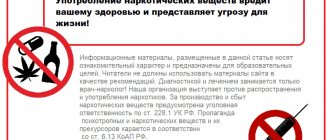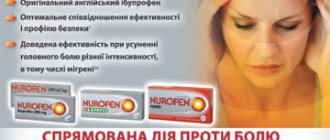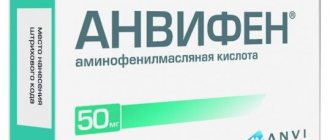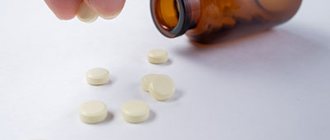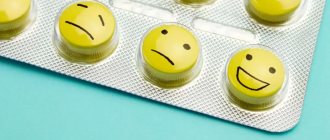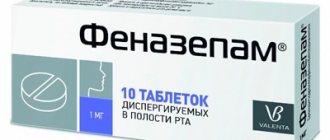Nootropic drugs are drugs that activate metabolic processes in nerve cells and help improve mental activity. This group includes pyrabene, lucetam, nootropil and phenotropil: we will try to find out which of the last two representatives of this class is better.
Such medications are being developed for patients with neurological problems, if necessary, to protect the brain from destruction by activating nerve cells. This is necessary so that patients can live and feel like healthy people.
Share
Tweet
Share
Cool
Send
Pharmacokinetics
When taken orally, it is quickly and almost completely absorbed from the gastrointestinal tract. Cmax in plasma is reached after approximately 30 minutes, in cerebrospinal fluid - after 2-8 hours. The apparent Vd is 0.6 l/kg. Does not bind to blood plasma proteins.
Distributed in all organs and tissues, penetrates the BBB and the placental barrier. Selectively accumulates in the tissues of the cerebral cortex, mainly in the frontal, parietal and occipital lobes, in the cerebellum and basal ganglia.
T1/2 from plasma is 4-5 hours, from cerebrospinal fluid - 6-8 hours. It is excreted unchanged by the kidneys. In renal failure, T1/2 increases.
The development of neuroleptic (antipsychotic) drugs occupies a special place in psychopharmacology. Despite the fact that these drugs are widely available, the search for new substances with antipsychotic activity remains an urgent task. A common feature of the currently existing antipsychotics is their ability to block dopamine D2 receptors, which until recently was considered the only possible mechanism responsible for the antipsychotic effect. At the same time, the functional heterogeneity of dopaminergic pathways in the brain leads to the fact that blockade of D2 receptors can cause extrapyramidal disorders, hyperprolactinemia and secondary negative symptoms - side effects characteristic of typical antipsychotics. New generations of antipsychotics, called atypical, differ from their predecessors mainly by a lower risk of developing extrapyramidal disorders, better effectiveness against negative symptoms and resistant forms of schizophrenia, and also a lower ability to cause catalepsy in experimental animals [4]. In addition, they are characterized by a certain selectivity of influence on dopaminergic pathways and a breadth of receptor binding profile, including effects on different types of dopamine (D1, D2, D3, D4, D5), serotonin (5-HT2A, 5-HT2C) and other receptors [4 ].
While some progress has been made in the treatment of productive psychotic symptoms, the treatment of polymorphic diseases such as schizophrenia requires a more differentiated approach, including equally effective treatment of negative, affective and cognitive disorders. This is why the active search for new antipsychotic drugs is being conducted in directions that differ from the traditional dopaminergic concept of schizophrenia. Substances that affect glutamatergic, cholinergic, serotonergic, GABAergic, neuropeptide, cannabinoid and other brain systems are considered candidates for new generation antipsychotic drugs [5].
Conceptualization of modulation and divergence (V.I. Akhapkina, 2006) allows us to significantly expand the basic boundaries of the classification of drugs and identify new approaches in the prevention and treatment of various disorders and diseases [1-3]. Modulators (commensurate influence) and divergents (divergence of influence) combine both stimulation and suppression in basic activity. For modulators, the predominant manifestation of the direction of one or another system-forming functional and/or pathogenetic type of action is directly related to the initial state of the body for various types of norm and various types of disorder of the norm, and for divergents - with the dose of the drug. Many well-known drugs (Mexidol, Phenibut, Pantocalcin) have divergent activity.
In some doses they exhibit a stimulating effect, while in others they have a suppressive effect. The ancestor of the class of modulators with a unique proportional effect is phenotropil or (RS)-2(2-oxo-4-phenylpyrrolidin-1-yl)-acetamide.
The combination of promotemodulatory and unimodulatory properties of phenotropil, the ability of the enantiomeric biologically active (R) and (S) substances included in its composition to complementarity, conformation and reversibility depending on the state of the environment in which they are located, served as the basis for studying the likelihood of having a neuroleptic activity.
The purpose of this study is to identify and evaluate the neuroleptic activity of phenotropil by experimentally reproducing changes in the functions of some neurotransmitter systems of the brain.
Material and methods
The study of the neuroleptic activity of phenotropil was carried out in accordance with the Guidelines for the Experimental (Preclinical) Study of New Pharmacological Substances [4] using the following methods: 1) administration of apomorphine to animals, which makes it possible to simulate the manifestations of positive symptoms of schizophrenia associated with hyperactivation of the dopamine system; 2) reproduction of hyperkinesis by administering 5-hydroxytryptophan, which makes it possible to simulate the manifestations of negative symptoms of schizophrenia associated with hyperactivation of the serotonergic system; 3) induction of tremor by administration of arecoline, which makes it possible to simulate hyperactivation of the central M-cholinergic system, which is considered as a link in the pathogenesis of psychoses; 4) inducing haloperidol catalepsy (freezing reaction), which makes it possible to simulate the blockade of dopamine receptors; 5) open field technique, which makes it possible to identify the influence of substances on psychomotor behavioral reactions; 6) a technique for provoking aggression in animals grouped in pairs on an electrical platform, which allows one to evaluate the effectiveness of substances in conditions of directed aggression.
The experiments were performed on white outbred male mice weighing 18-24 g and male rats weighing 180-220 g. Phenotropil in doses of 12.5; 25; 50; 100; 200 and 300 mg/kg and the reference drug olanzapine in doses of 1 and 10 mg/kg were administered intraperitoneally 40 minutes before the start of observations. Apomorphine (2 mg/kg) and arecoline (25 mg/kg) were administered subcutaneously immediately before the start of the experiment, 5-hydroxytryptophan (300 mg/kg) was administered intraperitoneally 40 minutes after the study drug and immediately before the start of the study, haloperidol (0.5 mg/kg) - intraperitoneally one hour before the examination.
Control animals were injected only with the solvents used for the listed substances (distilled water or saline solution).
Each group included at least 20 animals.
The results were processed using the statistical package Biostat for Windows using parametric t
-Student's t-test.
Results and discussion
In the apomorphine verticalization test, the mouse was placed in a special cylindrical chamber made of wire rods. For 60 minutes, the specific behavior of the animals was recorded according to the phenomenon of verticalization, which is characterized by standing on their hind legs, grabbing and climbing on bars, biting, gnawing, and sniffing. The total score was calculated based on the number of paws on the grid. This test has the greatest prognostic value for identifying the actual antipsychotic effect of substances. Under the conditions of this test, both typical and atypical antipsychotics have the ability to suppress the phenomenon of verticalization.
In the group of animals that received apomorphine, the intensity of verticalization was 49 points (Table 1)
.
Phenotropil in the studied doses (100, 200 and 300 mg/kg) with a single administration has a pronounced neuroleptic effect, significantly reducing the intensity of apomorphine verticalization by 47, 53 and 65%, respectively, which indicates the presence of neuroleptic activity in the drug with positive symptoms of schizophrenia.
The atypical antipsychotic olanzapine at a dose of 1 mg/kg did not have a significant effect on apomorphine verticalization. Under the influence of the drug, a decrease in the intensity of verticalization was observed to 38 points, i.e. it decreased by only 22%. At a dose of 10 mg/kg, olanzapine reduced the verticalization rate by 91%. The severity of the antipsychotic - dopaminergic effect of phenotropil increases with increasing dose, exceeding the effectiveness of olanzapine at a dose of 1 mg/kg by 2-3 times, and is inferior to it at a dose of 10 mg/kg by an average of 36% (44-38-26%, respectively). The administration of 5-hydroxytryptophan caused specific hyperkinesis in mice, expressed in characteristic sharp shaking of the head (head twitches), which reflects hyperactivation of the serotonergic system. The number of shakes was recorded individually for each animal for 60 min. In the control group of mice, 5-hydroxytryptophan caused an average of 11.3 shakes for the group during the observation period, taken as 100% (Table 2)
.
Olanzapine at a dose of 1 mg/kg completely eliminated head shaking caused by 5-hydroxytryptophan.
Phenotropil in all studied doses (12.5; 25; 50; 100; 200 and 300 mg/kg) reduced the number of head shakes by 72, 74, 82, 88, 87 and 89%, respectively. Along with the prevention of the development of hyperkinesis by phenotropil, the administration of 5-hydroxytryptophan (300 mg/kg) 40 minutes after phenotropil (300 mg/kg) caused stereotypy in 90% of mice and tremor in 20%. In addition, in the experimental groups with phenotropil (100, 200 and 300 mg/kg) after the end of the experiment and 2-3 hours after the administration of 5-hydroxytryptophan, animal mortality was observed: 4 mice out of 20 (20%), 6 out of 20 (30 %) and 10 out of 20 (50%), respectively. The results of this series of experiments indicate that phenotropil has more complex connections with the serotonergic system than with the dopaminergic system. This phenomenon requires an in-depth study of the effect of the drug on the serotonergic system in conditions of its hyperfunctional state and with severe deficiency. There are no reasons yet to exclude the opposite effect of phenotropil on the serotonergic system, not as a proactive agent, but as a therapeutic agent against the background of its hyperactivation, since they are not yet complete. At the same time, the study of some mechanisms of action of phenotropil (100 mg/kg) during a course of administration (7 days) showed that in conditions without pathology it statistically significantly (by 16-20%) reduces the density of serotonin 5-HT2 receptors in the frontal cortex of rats. In the test with arecoline (Table 3)
The total duration of tremor of the whole body of mice was recorded.
Arecoline (25 mg/kg) was administered 40 min after administration of the study drugs.
Observations were carried out for 30 minutes after its administration. Phenotropil at doses of 200 and 300 mg/kg reduced the duration of arecoline tremor by 63 and 50%, respectively, compared to the control group, and at a dose of 100 mg/kg increased the duration of tremor by 44%. Olanzapine at a dose of 1 mg/kg reduced the duration of tremor in mice by 57%. The severity of the effect of olanzapine at the dose studied was slightly lower than that of phenotropil at a dose of 200 mg/kg. Thus, phenotropil in doses of 200 and 300 mg/kg has a significant effect on reducing the hyperactivation of the M-cholinergic system, which is considered as an important link in the pathogenesis of psychosis, and also makes it possible to identify the likelihood of developing adverse reactions during the use of antipsychotics. Catalepsy (freezing reaction, animal hypnosis, imaginary death) in humans is a manifestation of psychopathological behavior characteristic of some affective disorders, agitated depression and a number of forms of schizophrenia. The use of neuroleptics can also lead to the development of a cataleptic state. In experiments, catalepsy is usually induced by morphine and haloperidol. The results of a study of the effect of phenotropil (50, 100, 200 and 300 mg/kg) on haloperidol catalepsy are presented in table. 4
.
Haloperidol after administration at a dose of 0.5 mg/kg causes the development of catalepsy, the duration of which was 1.5 s after 60 minutes, 28.3 s after 120 minutes and 64.5 s after 180 minutes (see Table 4)
. Phenotropil is an antagonist to haloperidol catalepsy and prevents the development of extrapyramidal disorders. When haloperidol (0.5 mg/kg) was co-administered with phenotropil at a dose of 50 mg/kg, no catalepsy was observed after 60 minutes. After 120 minutes it was lower by 72% compared to the control group, and after 180 minutes the duration of catalepsy decreased by 94%. Phenotropil at a dose of 100 mg/kg completely eliminated the development of haloperidol catalepsy. Against this background, at a dose of 300 mg/kg after 60 minutes, the duration of catalepsy increased slightly compared to the control, amounting to 4.3 s. After 120 and 180 minutes it averaged 9.7 and 19.2 s, which is 66 and 70% lower compared to the control group. In this test, the effectiveness of phenotropil is diametrically opposed to its effect on dopamine during apomorphine verticalization.
Directed provocation of aggression was caused by electrical pain stimulation on an electrical platform in rats grouped in pairs 40 minutes after a single administration of phenotropil in doses of 25; 50; 100; 200 and 300 mg/kg and course (300 mg/kg for 21 days). The number of fights was determined each time during 5 minutes of observation. During the course of administration, aggression was assessed on days 1, 7, 14 and 21.
The number of fights taken as 100% in the control group (distilled water) during the observation period averaged 24.8 (Table 5)
.
Administration of phenotropil in all studied doses reduced the number of fights compared to the control group by: 32 and 33% - at doses of 25 and 50 mg/kg, respectively, 42% - at a dose of 100 mg/kg, 39% - at a dose of 200 mg/kg and 48% at a dose of 300 mg/kg. On the 7th day, phenotropil at a dose of 300 mg/kg reduced the manifestation of aggression by 39%, and on the 14th and 21st days this indicator did not differ significantly from the animals in the control group (saline) and amounted to only 6-7% ( table 6)
. Phenotropil, with single or course use, not only does not potentiate the manifestation of directed aggression, but significantly reduces it when provoked by an external stimulus that cannot be avoided.
A study of the effect of phenotropil on mice in an open field test was performed to study the possible sedative effect, since known typical and some atypical antipsychotic drugs cause depression of motor activity. The animals were placed singly in the center of the area, divided into squares (8×8 cm) and having 16 holes with a diameter of 1.5 cm, 40 minutes after drug administration. Observations were carried out for 3 minutes. Vertical (number of standing up) and horizontal (number of crossed squares) motor activity, number of holes examined in the floor, number of washings, and number of exits to the center of the open field were recorded. Phenotropil (100, 200 and 300 mg/kg) and olanzapine (1 mg/kg) were administered intraperitoneally once.
The total number of crossed squares in 3 minutes was 42.5±6.1 in the control group that received distilled water (Table 7)
.
Olanzapine at a dose of 1 mg/kg significantly reduced horizontal motor activity, reducing the total distance traveled by 36%.
Phenotropil at doses of 100, 200 and 300 mg/kg significantly increased horizontal activity. The total indicator of horizontal motor activity against the background of phenotropil increased at a dose of 100 mg/kg by 99%, at a dose of 200 mg/kg - by 152%, and at a dose of 300 mg/kg - by 112%.
The number of vertical posts in the control group was 3.2±1.7.
Olanzapine also had a pronounced depressive activity for this indicator (see Table 7)
, reducing the number of racks by 47%. Phenotropil at a dose of 100 mg/kg significantly increased total vertical motor activity by 242%. At a dose of 200 mg/kg with phenotropil, vertical motor activity did not change compared to the control, and at a dose of 300 mg/kg under the influence of the drug, a significant increase in the number of stances was observed by 58%. Based on the ratio of vertical and horizontal struts, we can say that Phenotropil has antidepressant activity.
The number of examined holes in the control group was 2.2±0.7. Olanzapine did not change this figure. Phenotropil increased the number of examined holes by 50 and 21% at doses of 100 and 300 mg/kg and decreased by 32% at a dose of 200 mg/kg (see Table 7)
.
In terms of the number of trips to the center of the field, olanzapine worsened the indicator by 2.6 times. Phenotropil at doses of 100, 200 and 300 mg/kg significantly increased the number of trips to the center of the field by 2.2, 2.6 and 2.3 times, respectively, compared to the control (see Table 7)
, which indicates that the drug has a pronounced anxiolytic effect.
The movements of animals in an unfamiliar environment, reminiscent of washing, characterize an anxious state. In the control group, the number of washings at the 1st and 2nd minutes of observation was 0.2±0.2. At the 3rd minute, no washing was observed in the control group. The average total number of washes in the control over 3 minutes was 0.4±0.2 (Table
.
Olanzapine at a dose of 1 mg/kg increased the number of washings by 2.5 times both at the 1st and 2nd minutes of observation.
At the 3rd minute, the number of washings decreased, but compared to the control it increased by 2 times. According to the total indicator, the number of washings exceeded the control indicator by 3.0 times. Phenotropil at a dose of 100 mg/kg did not affect the number of washes. When administered at a dose of 200 mg/kg, no washes were observed, and at a dose of 300 mg/kg, washes were observed only in the 1st minute and did not differ from the control group. The presented results showed that phenotropil has pronounced antipsychotic activity when studied in models with hyperactivation of the dopamine system. It is important to emphasize that phenotropil exhibits an opposite effect in the same doses depending on the outcome of catalepsy, demonstrating pronounced antagonism to the dopamine blocker, eliminating or significantly reducing catalepsy depending on the dose. The identified features of the influence of phenotropil also indicate its complex interaction with the serotonergic system. Its effects in this case are modulatory in nature, depending on the initial state. Phenotropil does not provoke or potentiate aggression. By reducing aggressive behavior, it maintains control of higher mental functions in the presence of an objective threat and its provocation. This component of action can be especially useful in practically healthy people under extreme conditions.
In contrast to olanzapine and typical antipsychotics that have a sedative effect, phenotropil does not exhibit such an effect, having a positive effect on exploratory behavior and motor activity in an unfamiliar environment, and also acts as an anxiolytic and antidepressant.
Drug interactions
A case of interaction of piracetam with simultaneous use with a thyroid extract containing triiodothyronine and tetraiodothyronine is described, when the patient experienced anxiety, irritability and sleep disorders.
When used simultaneously with thyroid hormones, the development of central effects is possible - tremor, anxiety, irritability, sleep disturbances, confusion.
With the simultaneous use of central nervous system stimulants, the psychostimulating effect may be enhanced.
When used simultaneously with antipsychotics, an increase in extrapyramidal disorders is observed.
Which is better: reviews from doctors
Doctors speak positively about the use of nootropil in the treatment of children. As for the adult category of patients, the attitude towards this drug is ambiguous due to lack of effectiveness, as well as the presence of adverse reactions.
Nikolaev I.P., neurologist: In most patients, this remedy did not show itself in any way. But the side effects are very pronounced: insomnia, tremors, headaches, agitation. I believe that the inflated cost of nootropil is not justified; it does not provide a better effect than phenotropil.
Artemyev N. G., pediatrician: When prescribed, nootropil exhibits a pronounced anti-asthenic effect. Activator. I recommend it for hypotensive and hyposthenic patients in the form of injections.
Sinyaev V.S., neurologist: The advantages of nootropil are efficiency and ease of use. In some people it provokes excessive activity. I use it widely in practice, for prevention in cases of reduced concentration, poor memory, and pathological fatigue. Sometimes I prescribe a remedy for apathy or the treatment of other diseases. The drug works well in the complex treatment of people after TBI or stroke.
Many experts consider Phenotropil to be a higher quality medicinal product, unlike its opponent.
Pokotilov R.V., psychiatrist: After taking these pills, patients sometimes experience a lethargic state and clarity of thinking disappears. This phenomenon is caused by the fact that the ingredients of phenotropil force the brain to look for increased energy, drawing it from hidden resources. And the body has to renew them. When the effect of the medication wears off, the person feels unpleasantly tired. Its duration depends on the duration of taking the drug.
Pregnancy and lactation
Adequate and strictly controlled studies of the safety of piracetam during pregnancy have not been conducted. Use is possible only in cases where the expected benefit to the mother outweighs the possible risk to the fetus.
Piracetam appears to pass into breast milk. If it is necessary to use it during lactation, the issue of stopping breastfeeding should be decided.
Experimental studies on animals did not reveal any negative effects of piracetam on the fetus.
Termination of production of phenotropil
Many of you are faced with the impossibility of purchasing such an effective nootropic as Phenotropil in pharmacies. This is due to the cessation of its production by Valenta-Pharm due to patent disputes with the inventor, Valentina Akhapkina. Her plans were to expand the field of application of the drug and introduce new dosage forms (including injections), but the manufacturing company refused this. Phenotropil produced by Akhapkina’s own company (Vira Innfarm) is not yet available for purchase. The Baltic generic is also currently unavailable.
General principles of action of nootropics
Pyrrolidone nootropics, and in particular Phenotropil and piracetam, are characterized by low toxicity and the absence of pronounced side effects, even in subtoxic doses. The mechanisms of implementation of the effects of nootropics are close to natural and reflect their neurometabolic action. Thus, the electrophysiological mechanisms of action of nootropics are expressed in facilitating the passage of information between brain structures, enhancing synaptic transmission, increasing the level of wakefulness, enhancing the absolute and relative power of the EEG spectrum of the cortex and subcortical structures, in particular the hippocampus.
The mechanism of the neurochemical effects of pyrrolidone nootropics is determined by the stimulation of metabolic, bioenergetic and plastic processes in the brain, incl. enhancing the synthesis of protein and phospholipids, increasing the rate of turnover of information molecules. There is no evidence yet for the existence of intrinsic receptors for pyrrolidone nootropics, and they have been shown to not have high affinity for most known receptors. At the same time, pyrrolidone nootropics affect the main synaptic systems - cholinergic, adrenergic, dopaminergic, GABAergic and glutamatergic, and in the direction in which these systems are related to memory and the body’s adaptation to extreme influences.
What's the matter?
In modern Russia, there are practically no different activating, stimulating substances available. Previously it was Ladasten, but in the end it stopped being produced, there was Bupropion until 2021, now they generally get jailed for it. There was Modafinil, which in most countries of the world is a medicine or a supplement, but in our country in 2012, suddenly it was a drug, and Mesocarb also disappeared.
Today, the substance phenylpiracetam, also known as phenylpiracetam, also known as Phenotropil, and now also known as Nanotropil Novo, is a more or less normal activating nootropic. He gets so much attention not because of his good life, this is not advertising (advertising as usual here) but because there are no pharmacy analogues. Although some will be further.


